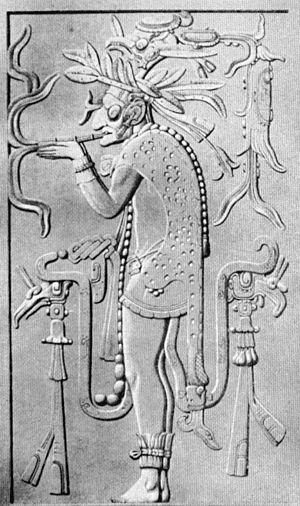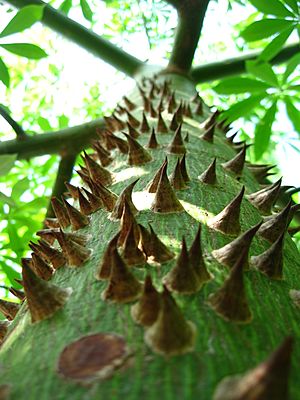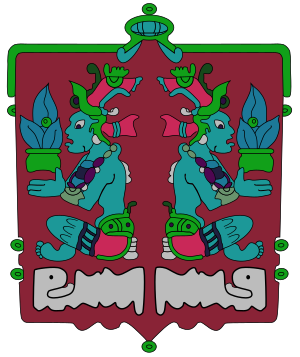Ah Canul facts for kids
Quick facts for kids
Kuchkabal Ah Canul
|
|||||||||
|---|---|---|---|---|---|---|---|---|---|
| 1443–1541 | |||||||||

Kuchkabals of Yucatan after 1461.
|
|||||||||
| Capital | Calkini | ||||||||
| Common languages | Official language: Yucatec |
||||||||
| Religion | Maya religion | ||||||||
| Government | Oligarchy | ||||||||
| Halach Uinik | |||||||||
| Historical era | Post Classic Period / Early Modern | ||||||||
|
• Established
|
1443 | ||||||||
|
• Disestablished
|
1541 | ||||||||
|
|||||||||
Ah Canul was the name of a powerful Maya region, or Kuchkabal. It was located in the northwest part of the Yucatán Peninsula. This was before the Spanish conquistadors arrived in the 1500s.
Contents
What Does Ah Canul Mean?
The name Ah Canul means "protector." It comes from the Maya word canan, which means "to guard" or "to protect."
How Ah Canul Was Organized
After the city of Mayapan was destroyed (between 1441 and 1461), the Yucatán Peninsula saw many rivalries. About 16 or 17 separate regions, called Kuchkabals, were formed.
Leaders of the Kuchkabal
Each Kuchkabal had a main leader called a Halach Uinik. This leader had the highest power in military, law, and politics. They lived in the main city, which was the capital of their Kuchkabal.
Each Kuchkabal was divided into smaller areas called batabilob. These were like towns or municipalities. A batab governed each batabil. The batabob followed the Halach Uinik and were often part of the same families.
Local Councils and Priests
Each batabil was also divided into even smaller groups called kuchkteel, or family units. These small councils were in villages and were made up of extended families. Their representatives, called ah k'ul, met to solve important issues. The batab also joined these meetings.
The Halach Uinik was also the highest religious leader of their Kuchkabal. Other important religious leaders included:
- Ah K'in May (next in command)
- Ah k'in (regular priests)
- Ah nakom (sacrificers)
- Chilam (prophets)
- Chako'ob (lower-ranking priests)
The Halach Uinik was also the top military leader. They chose a captain called a nacom. This captain helped coordinate the batabob, who also held high military ranks.
Ah Canul's Unique Government
For Ah Canul, the capital city was Calkini. However, Ah Canul was different because it did not have a single Halach Uinik. Instead, the batabob formed a senate. This senate met under a Ceiba tree, which was considered sacred. They would discuss and agree on important decisions for their communities.
History of Ah Canul
The End of the League of Mayapan
Shortly after the Ah Canul people arrived in the area, a civil war broke out. This was between two powerful groups, the Cocomes and the Tutul-Xiu, who were part of the League of Mayapan. Even with help from the Canul family, the League was destroyed. Xupan Ah Xiu, a great lord from Uxmal, led the army that defeated the Cocom royal family. Only one Cocom survived because he was in Honduras at the time. He later founded a new town called Tibolón.
A famous account by Diego de Landa describes this time:
"One of the Cocom leaders became very proud and started to act like the earlier Cocoms. He made a new alliance with Tabasco and brought more Mexicans into the city. He began to bully smaller groups and make them slaves. So, the other leaders, led by Tutu Xiu, decided to kill Cocom. They did this, and also killed all his children except for one who was away. They robbed his house, taking his cocoa and other goods, saying it was payment for what he had stolen. This started a long fight between the Cocomes and Xiues. It ended over 500 years of prosperity for that city, leaving it empty and abandoned. Each person went back to their own land..." – An Account of the Things of Yucatan, Diego de Landa
After this war, large cities were left empty. The regions that were once part of the League became independent Kuchkabals. The Canul guards then began to move west, into the area known as Camino Real. The Canche family also seemed to move with them.
Founding of Ah Canul Kuchkabal
The League of Mayapan was destroyed between 1441 and 1461. After this, Ah Canul was divided into eight batabilob. These were ruled by different batabob, including:
- Ah Tzab Canul
- Ah Dzun Canul
- Ah Kin Canul
- Ah Paal Canul (or Ah Pa Canul)
- Ah Sulim Canul
- Ah Chacah Canul
- Ix Pacab Canul (or Ix Copacab Canul)
- Nah Bich Canul
In 1443, these leaders gathered under a Ceiba tree in Calkini. They agreed to form their own Kuchkabal. They chose Ah Tzab Canul, the oldest among them, to be their Halach Uinik (Ruler). However, after he died, the batabob decided to form a senate instead of choosing a new Halach Uinik.
Spanish Conquest
The Spanish believed that Ah Canul would join them in their third attempt to conquer the Maya Kuchkabals in Yucatán. But most of the Ah Canul batabob refused, especially the batab of Calkiní.
Francisco de Montejo's nephew, along with native allies and 40 Spanish soldiers, forced Ah Canul to surrender. The Ah Canul people tried hard to stop the Spanish advance.
After the fighting, the Spanish moved through towns like Tenabo, Hecelchakán, Calkiní, Tuchicán, and Maxcanú. The Spanish stopped in Tenabo and Calkiní to get more supplies and organize their forces. This was because in Pocboc, in 1541, their camp had been burned, and they lost their supplies, clothes, and ammunition.
Economy of Ah Canul
Before the Spanish arrived, the Maya civilization was very active in trade and sea travel. Some Kuchkabals produced cocoa, while others produced salt. Ah Canul was known for producing cotton.
After the Spanish conquered the northern and southern coasts, Ah Canul became a major region for producing salt. They had to pay tribute (taxes) in salt under the new Spanish rule.
See also
 In Spanish: Ah Canul para niños
In Spanish: Ah Canul para niños





